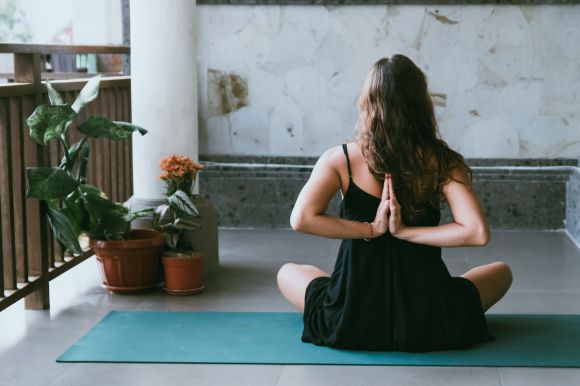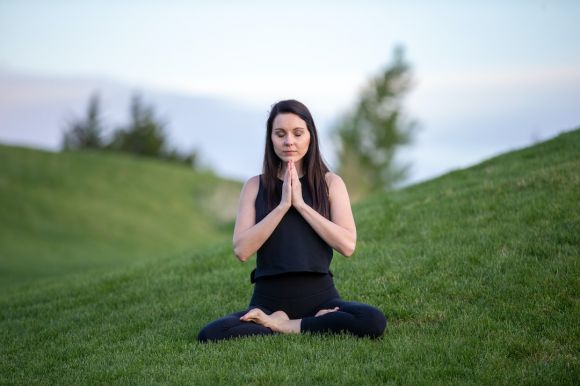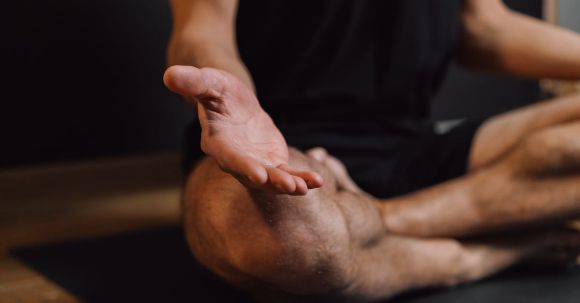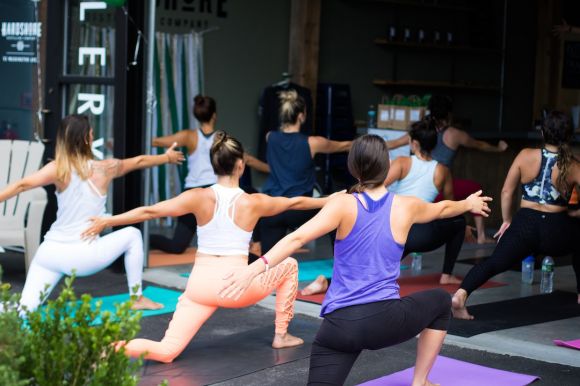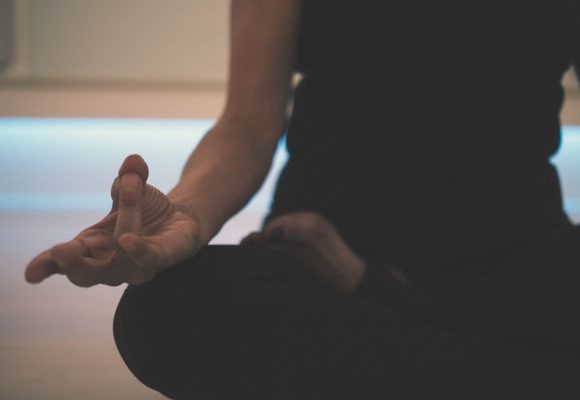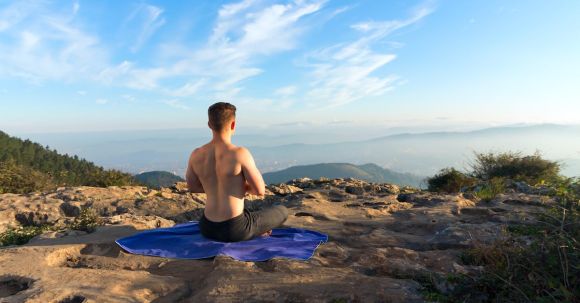Yoga is not just a physical exercise; it is a journey towards self-discovery and inner growth. Whether you are a beginner or have been practicing for years, there are always ways to take your yoga practice to a deeper level. Here are some effective techniques to help you deepen your yoga practice and experience its transformative power.
Yoga and meditation
In today's fast-paced world, many people struggle to get a good night's sleep. Stress, anxiety, and a constant stream of thoughts can often keep us awake, tossing and turning. However, there are simple and effective ways to improve your sleep quality. Yoga and meditation, when practiced regularly, can help you relax, calm your mind, and achieve a more restful sleep. In this article, we will explore how these ancient practices can be integrated into your daily routine to promote better sleep.
Reducing Stress with Yoga
Stress is one of the main culprits behind sleepless nights. The physical and mental tension we accumulate throughout the day can make it challenging to unwind and fall asleep. Yoga, with its focus on deep breathing and gentle stretching, can be incredibly effective in reducing stress levels. Start with simple yoga poses that target areas of tension in your body. The child's pose, for example, gently stretches the back and shoulders, releasing tension and promoting relaxation. Combine this with slow and mindful breathing, focusing on each inhale and exhale, to further calm your nervous system. Another beneficial pose for stress relief is the legs-up-the-wall pose. Lie on your back with your legs resting vertically against a wall. This pose helps to reverse the blood flow and activate the relaxation response in your body. Stay in this position for a few minutes and allow your mind to let go of any worries or distractions.Calming the Mind with Meditation
A busy mind can be a major obstacle to falling asleep. Racing thoughts and constant mental chatter can keep us awake for hours. Meditation is a powerful tool that can help quiet the mind, promoting a state of calm and relaxation. Start by finding a quiet and comfortable space where you can sit or lie down. Close your eyes and bring your attention to your breath. Focus on the sensation of each inhale and exhale, letting go of any thoughts that arise. If your mind starts to wander, gently bring your attention back to your breath. Practice this for a few minutes each day, gradually increasing the duration as you become more comfortable. Body Scan Meditation is another effective technique for promoting relaxation and better sleep. Lie down in a comfortable position and bring your attention to different parts of your body, starting from your toes and moving up to your head. Notice any areas of tension or discomfort and consciously relax those muscles. This practice helps to release physical tension and brings a sense of calm to the entire body.Creating a Bedtime Routine
In addition to incorporating yoga and meditation into your daily routine, establishing a bedtime routine can significantly improve your sleep quality. Create a calming atmosphere in your bedroom by dimming the lights, playing soothing music, or using essential oils known for their relaxation properties, such as lavender. Avoid using electronic devices at least an hour before bed, as the blue light emitted from screens can interfere with your sleep-wake cycle. Instead, engage in activities that promote relaxation, such as reading a book, taking a warm bath, or practicing gentle stretches. Conclusion: Embrace the Power of Yoga and Meditation for a Good Night's Sleep By incorporating yoga and meditation into your daily routine and creating a bedtime ritual, you can enhance your sleep quality and wake up feeling refreshed and rejuvenated. These practices not only help to reduce stress and calm the mind but also promote overall well-being. So, take a deep breath, roll out your yoga mat, and let the power of yoga and meditation guide you to a peaceful night's sleep.
Negative thoughts and emotions can be overwhelming and can have a significant impact on our overall well-being. They can consume our minds, drain our energy, and hinder our ability to live a happy and fulfilled life. However, there is a powerful tool that can help us overcome these negative thoughts and emotions - meditation.
Understanding Negative Thoughts and Emotions
Before we delve into how meditation can help us overcome negative thoughts and emotions, let's first understand what they are. Negative thoughts are those pesky little voices in our heads that constantly criticize, doubt, and judge ourselves and others. They can be self-sabotaging and can lead to feelings of anxiety, sadness, and anger. Emotions, on the other hand, are the physiological and psychological responses to our thoughts. They can range from mild irritation to intense anger, from sadness to despair. Negative emotions can be triggered by a variety of factors such as past traumas, stressful events, or even our own thoughts and beliefs.The Power of Meditation
Meditation is a practice that has been around for centuries and has been used by people from various cultures and backgrounds to achieve a sense of calm and inner peace. It is a simple yet powerful technique that involves focusing our attention and quieting the mind. By practicing meditation regularly, we can train our minds to become more aware of our thoughts and emotions. This heightened awareness allows us to observe our negative thoughts and emotions without getting caught up in them. We become like a silent observer, detached from the constant chatter of our minds.Cultivating Positive States of Mind
One of the main benefits of meditation is its ability to help us cultivate positive states of mind. Through meditation, we can develop qualities such as compassion, patience, and gratitude. These positive states of mind can counteract the negative thoughts and emotions that often plague us. By focusing on positive thoughts and emotions during meditation, we can rewire our brains and create new neural pathways. This can lead to a shift in our mindset, making us more resilient in the face of negative thoughts and emotions.Letting Go of Attachments
Another way meditation can help us overcome negative thoughts and emotions is by teaching us to let go of attachments. Often, our negative thoughts and emotions are fueled by our attachment to certain outcomes or beliefs. We become so invested in our thoughts and emotions that we lose sight of the present moment. Through meditation, we can learn to let go of these attachments and embrace the present moment as it is. We can detach ourselves from our negative thoughts and emotions and realize that they are transient and impermanent. This realization can bring a sense of freedom and lightness to our lives.Finding Inner Peace
Ultimately, the goal of meditation is to find inner peace. By regularly practicing meditation, we can create a space within ourselves that is calm, serene, and unaffected by the ups and downs of life. This inner peace can act as a shield against negative thoughts and emotions, allowing us to navigate through life with grace and resilience.Conclusion: Embracing the Power of Meditation
Negative thoughts and emotions are a part of life, but they do not have to control us. By embracing the power of meditation, we can overcome these negative thoughts and emotions and live a more peaceful and fulfilling life. So, why not start your meditation practice today and experience the transformative effects it can have on your well-being?
In today's fast-paced world, it's easy to get caught up in the chaos of daily life. We often find ourselves constantly multitasking, thinking about the past or worrying about the future. This lack of presence can lead to stress, anxiety, and a general feeling of being disconnected from ourselves and those around us. However, by incorporating yoga and meditation into our daily routine, we can cultivate mindfulness and presence, allowing us to live more fully in the present moment.
The Power of Yoga
Yoga is a practice that combines physical postures, breath control, and meditation. It has been practiced for thousands of years and has numerous benefits for both the body and mind. One of the primary goals of yoga is to bring the practitioner into a state of mindfulness and presence. Through the practice of yoga, we learn to focus on our breath and the sensations in our body. We become aware of our thoughts and emotions without judgment or attachment. This awareness allows us to let go of the past and future, and be fully present in the moment. By regularly practicing yoga, we can train our minds to be more present and focused. This can have a profound impact on our overall well-being, as we become more attuned to our bodies and more aware of our thoughts and emotions.The Benefits of Meditation
Meditation is another powerful tool for cultivating mindfulness and presence. It involves training the mind to focus on a single point of awareness, such as the breath, a mantra, or a visual object. Through consistent practice, we can develop a greater sense of calm and clarity. Meditation has been scientifically proven to reduce stress, anxiety, and depression. It also improves concentration, enhances creativity, and promotes a sense of overall well-being. By regularly practicing meditation, we can become more present in our daily lives, leading to greater happiness and fulfillment.Integrating Yoga and Meditation
While yoga and meditation are powerful practices on their own, they are even more effective when combined. By integrating yoga and meditation, we can deepen our mindfulness and presence. Start by incorporating a few minutes of meditation into your yoga practice. After completing your physical postures, find a comfortable seated position and focus on your breath. Notice the sensations in your body and the thoughts that arise. Simply observe them without judgment, and gently bring your attention back to your breath whenever you become distracted. Over time, you can gradually increase the duration of your meditation practice. Set aside a specific time each day to sit in meditation, even if it's just for a few minutes. As you continue to cultivate mindfulness and presence through yoga and meditation, you'll begin to experience the benefits in all areas of your life.Conclusion: Embrace the Present Moment
In a world that often feels chaotic and overwhelming, it's important to cultivate mindfulness and presence. By incorporating yoga and meditation into our daily routine, we can train our minds to be more present and focused. This allows us to fully embrace the present moment and live more fully in each experience. So, make a commitment to yourself today. Set aside time each day for yoga and meditation. Notice how these practices enhance your ability to be present and fully engaged in your life. Embrace the power of mindfulness and presence, and watch as your overall well-being flourishes.
In today's fast-paced world, finding ways to relax and take care of our mental and physical well-being is more important than ever. One popular way to achieve this balance is through the practice of yoga and meditation. These ancient practices have been used for centuries to promote health, reduce stress, and increase self-awareness. In this article, we will explore the numerous benefits that yoga and meditation can bring to your mind and body.
Stress Reduction and Relaxation
One of the primary benefits of yoga and meditation is their ability to reduce stress and promote relaxation. The deep breathing exercises and gentle stretching in yoga help to calm the nervous system and release tension in the body. Meditation, on the other hand, allows the mind to quiet down and focus on the present moment, relieving anxiety and promoting a sense of peace. Regular practice of these techniques can significantly reduce stress levels and improve overall well-being.Improved Mental Clarity and Focus
In addition to reducing stress, yoga and meditation can also enhance mental clarity and focus. The practice of yoga involves holding poses and focusing on the breath, which helps to improve concentration and increase mindfulness. Meditation, on the other hand, trains the mind to stay present and focused, reducing mental chatter and enhancing cognitive abilities. By incorporating these practices into your routine, you can experience improved mental clarity and better decision-making skills.Increased Flexibility and Strength
Yoga is well-known for its ability to increase flexibility and strength. Through a series of poses, yoga stretches and strengthens the muscles, improving overall flexibility and mobility. The regular practice of yoga can also help to tone and sculpt the body, leading to increased strength and endurance. Whether you are a beginner or an advanced practitioner, yoga offers a variety of poses and modifications that can be tailored to your individual needs and abilities.Enhanced Emotional Well-being
Yoga and meditation have been shown to have a positive impact on emotional well-being. The combination of physical movement, breath control, and mindfulness helps to release emotional blockages and promote a sense of inner peace. Regular practice of these techniques can improve mood, reduce symptoms of depression and anxiety, and increase overall happiness. By incorporating yoga and meditation into your daily routine, you can experience a greater sense of emotional balance and well-being.Improved Sleep Quality
For those struggling with sleep issues, yoga and meditation can be a game-changer. The relaxation techniques and deep breathing exercises in these practices help to calm the mind and prepare the body for sleep. Regular practice can improve sleep quality, reduce insomnia, and promote a more restful night's sleep. By incorporating a short yoga or meditation session before bed, you can create a relaxing bedtime routine that will help you unwind and prepare for a good night's rest. In conclusion, the benefits of yoga and meditation for the mind and body are numerous and well-documented. These practices offer a holistic approach to health and well-being, helping to reduce stress, improve mental clarity, increase flexibility and strength, enhance emotional well-being, and improve sleep quality. By incorporating yoga and meditation into your daily routine, you can experience these benefits and achieve a greater sense of balance and harmony in your life. So, why not give it a try and discover the transformative power of yoga and meditation for yourself?
Yoga is a powerful practice that not only improves flexibility and relaxation but also helps to strengthen and tone the core muscles of your body. The core, which includes the abdominal muscles, lower back muscles, and pelvic floor muscles, plays a crucial role in providing stability and support to the entire body. By incorporating specific yoga poses into your routine, you can effectively target and strengthen your core muscles, leading to better posture, balance, and overall strength. In this article, we will explore some yoga poses that are particularly effective in strengthening the core.
Plank Pose
Plank pose is a classic yoga pose that is excellent for strengthening the core muscles. To get into the pose, start in a push-up position with your hands directly under your shoulders and your body in a straight line from head to toe. Engage your core muscles by drawing your navel towards your spine and hold the pose for 30 seconds to a minute. Feel the burn as your core muscles work hard to maintain the stability of your body.Boat Pose
Boat pose is another powerful yoga pose for strengthening the core. Start by sitting on the floor with your legs extended in front of you. Lean back slightly and lift your feet off the ground, bringing your shins parallel to the floor. Extend your arms forward, parallel to the floor, and engage your core muscles by drawing your navel towards your spine. Hold the pose for 30 seconds to a minute, feeling the deep activation of your core muscles.Side Plank Pose
Side plank pose is a variation of the plank pose that specifically targets the oblique muscles, which are located on the sides of your abdomen. Start in a plank position and then shift your weight onto your right hand and the outer edge of your right foot. Stack your left foot on top of your right foot and lift your left arm towards the ceiling, creating a straight line from your head to your heels. Engage your core muscles and hold the pose for 30 seconds to a minute on each side.Bridge Pose
Bridge pose is a gentle backbend that not only strengthens the core muscles but also opens up the chest and shoulders. Lie on your back with your knees bent and your feet hip-width apart. Press your feet into the ground and lift your hips up towards the ceiling, engaging your core muscles to support your lower back. Interlace your fingers underneath your body and roll your shoulders back to open up your chest. Hold the pose for 30 seconds to a minute, breathing deeply into your abdomen.Conclusion: Strengthen Your Core with Yoga Poses
By incorporating these yoga poses into your routine, you can effectively target and strengthen your core muscles. Whether you are a beginner or an experienced yogi, these poses are accessible to all levels and can be modified to suit your individual needs. Remember to always listen to your body and work within your limits. With regular practice, you will notice improved core strength, better posture, and increased overall strength. So roll out your mat, take a deep breath, and get ready to strengthen your core with yoga poses.
In today's fast-paced and hectic world, it's no wonder that more and more people are turning to meditation as a way to find inner peace and calm. Meditation has been practiced for thousands of years and is known to have numerous benefits for both the mind and body. If you're a beginner looking to start your meditation journey, here are the basics you need to know.
What is Meditation?
Meditation is a practice that involves focusing your mind and eliminating the stream of thoughts that usually occupy it. It is a way to train your mind to be fully present and aware of the present moment. Through meditation, you can achieve a state of deep relaxation and clarity.Getting Started
To start your meditation practice, find a quiet and comfortable space where you won't be disturbed. Sit in a comfortable position, either on a cushion or a chair, with your back straight and your hands resting on your lap. Close your eyes and take a few deep breaths to relax your body.Focus on Your Breath
One of the most common techniques for beginners is to focus on their breath. Pay attention to the sensation of your breath as it enters and leaves your body. Notice the rise and fall of your abdomen or the feeling of air passing through your nostrils. Whenever your mind starts to wander, gently bring your attention back to your breath.Be Patient and Non-Judgmental
When you first start meditating, you may find that your mind is filled with thoughts and distractions. It's important to remember that this is completely normal. Don't get frustrated or judge yourself for not being able to quiet your mind. Instead, gently acknowledge the thoughts and let them go, bringing your attention back to your breath.Start with Short Sessions
As a beginner, it's best to start with short meditation sessions and gradually increase the duration over time. Begin with just five minutes a day and then gradually work your way up to longer sessions. Consistency is key, so try to meditate at the same time each day to establish a routine.Experiment with Different Techniques
There are many different meditation techniques to explore, so don't be afraid to experiment and find what works best for you. Some popular techniques include mantra meditation, where you repeat a word or phrase, and guided meditation, where you listen to a recorded meditation. Find a technique that resonates with you and feels comfortable.Benefits of Meditation
Meditation has numerous benefits for both the mind and body. Regular practice can reduce stress and anxiety, improve focus and concentration, enhance self-awareness, and promote emotional well-being. It can also help lower blood pressure, improve sleep quality, and boost the immune system.Conclusion
As a beginner, starting a meditation practice may seem overwhelming, but with patience and practice, it can become a valuable tool for finding inner peace and calm. Remember to be patient with yourself, start with short sessions, and experiment with different techniques. With time, you'll begin to experience the many benefits that meditation has to offer. So, why not start your meditation journey today?
In today's fast-paced and stressful world, it's no wonder that anxiety has become a common problem for many people. The constant demands and pressures of modern life can easily lead to feelings of overwhelm and unease. However, there is a simple practice that can help you overcome anxiety and find a sense of calm - meditation.
Understanding Anxiety
Before we delve into how meditation can help with anxiety, it's important to understand what anxiety is. Anxiety is a natural response to stress, but when it becomes chronic and excessive, it can interfere with our daily lives. Symptoms of anxiety may include restlessness, irritability, difficulty concentrating, and a constant sense of worry or impending doom. If left unmanaged, anxiety can negatively impact our physical and mental health.The Benefits of Meditation for Anxiety
Meditation has been practiced for thousands of years and has been proven to have numerous benefits for our overall well-being. When it comes to anxiety, meditation can be particularly effective in reducing stress levels and promoting a sense of calm. Here are some of the ways meditation can help: 1. Calming the Mind: Meditation allows us to observe our thoughts without judgment or attachment. By practicing mindfulness, we can develop a greater awareness of our thought patterns and learn to let go of negative or anxious thoughts. 2. Relaxing the Body: Anxiety often manifests in physical symptoms such as muscle tension, increased heart rate, and shallow breathing. Through meditation, we can learn to relax our bodies and activate the relaxation response, which counteracts the stress response. 3. Cultivating Gratitude and Positivity: Anxiety tends to make us focus on what could go wrong or what we lack. Meditation can help shift our mindset towards gratitude and positivity, allowing us to appreciate the present moment and cultivate a more optimistic outlook.Getting Started with Meditation
Now that we understand the benefits of meditation, let's explore how to get started. Here are some steps to help you begin your meditation practice: 1. Find a Quiet Space: Choose a quiet and comfortable space where you won't be easily distracted. It could be a corner in your home or even a park where you can sit in peace. 2. Sit Comfortably: Find a comfortable sitting position, either on a cushion or a chair. Make sure your back is straight but relaxed, and your hands are resting comfortably in your lap. 3. Focus on Your Breath: Close your eyes and bring your attention to your breath. Notice the sensation of the breath entering and leaving your body. If your mind wanders, gently bring it back to the breath. 4. Be Present: Allow yourself to fully experience the present moment. Notice any physical sensations, thoughts, or emotions that arise, but don't get attached to them. Simply observe and let go. 5. Start Small: Begin with just a few minutes of meditation each day and gradually increase the duration as you become more comfortable. Consistency is key, so aim for a daily practice.Finding Calm through Meditation
As you continue to practice meditation, you'll start to notice a shift in your overall sense of well-being. The more you cultivate mindfulness and relaxation, the more you'll be able to overcome anxiety and find calm in your daily life. Remember, meditation is a skill that takes time and patience to develop, so be kind to yourself throughout the process. In conclusion, meditation offers a powerful tool for overcoming anxiety and finding inner peace. By calming the mind, relaxing the body, and cultivating gratitude, meditation can help us navigate the challenges of life with greater ease and resilience. So why not give it a try? Start by carving out a few minutes each day to sit in stillness and watch as anxiety slowly fades away, replaced by a deep sense of calm.
Yoga is a powerful practice that not only strengthens and stretches the body but also has the ability to detoxify both the physical body and the mind. One of the most effective yoga postures for detoxification is the twist. Twisting poses are not only beneficial in increasing flexibility and mobility, but they also help in releasing toxins, improving digestion, and calming the mind. In this article, we will explore how yoga twists can detoxify your body and mind, and how to incorporate them into your practice.
Benefits of Yoga Twists
1. Stimulate Digestion: Twisting poses compress the digestive organs, which helps in stimulating digestion and improving overall gut health. When the organs are compressed, fresh blood flows into them, bringing oxygen and nutrients, and flushing out toxins and waste products. This increased blood flow helps in improving digestion and relieving symptoms of bloating and constipation. 2. Detoxify the Body: Twisting poses wring out the internal organs, which helps in detoxifying the body. As you twist, the organs are compressed, and when you release the twist, fresh blood flows into them, carrying away toxins and waste products. This process helps in improving the functioning of the organs and enhances the body's natural detoxification process. 3. Increase Spinal Mobility: Twisting poses improve spinal mobility and flexibility. As you twist, you lengthen and rotate the spine, which helps in releasing tension and tightness in the back muscles. A flexible spine is essential for overall health and vitality, as it allows for better circulation and nerve function. 4. Calm the Mind: Twisting poses not only detoxify the body but also have a calming effect on the mind. As you twist, you are required to stay present and focus on the breath. This mindful awareness helps in quieting the mind and reducing stress and anxiety. Twists also help in releasing tension stored in the body, which further promotes a sense of relaxation and calmness.Incorporating Yoga Twists into Your Practice
1. Seated Twist (Ardha Matsyendrasana): Sit on the floor with your legs extended in front of you. Bend your right knee and place your right foot on the outside of your left knee. Inhale and lengthen your spine, then exhale and twist towards the right, placing your left elbow on the outside of your right knee. Stay in the pose for a few breaths, then repeat on the other side. 2. Revolved Triangle (Parivrtta Trikonasana): Start in a standing position, with your feet hip-width apart. Step your left foot back about 3-4 feet and rotate it slightly to the left. Inhale and lift your arms to shoulder height, then exhale and hinge forward from the hips, placing your right hand on the outside of your left foot. Extend your left arm towards the ceiling, and gaze up towards your left hand. Stay in the pose for a few breaths, then repeat on the other side. 3. Supine Twist (Supta Matsyendrasana): Lie on your back with your knees bent and your feet on the floor. Extend your arms out to the sides at shoulder height. Inhale and lengthen your spine, then exhale and drop both knees to the right, twisting your spine. Keep both shoulders grounded on the floor. Stay in the pose for a few breaths, then repeat on the other side. Conclusion: Yoga twists are a valuable tool for detoxifying the body and mind. By incorporating twisting poses into your regular yoga practice, you can stimulate digestion, release toxins, increase spinal mobility, and calm the mind. Remember to listen to your body and practice with awareness and intention. With regular practice, you will experience the transformative power of yoga twists and enjoy the benefits of a detoxified body and a peaceful mind.
Yoga and meditation are both ancient practices that have been revered for their ability to promote physical, mental, and spiritual well-being. While yoga primarily focuses on the physical aspect, meditation delves into the realm of the mind. However, when combined, these practices can create a harmonious and transformative experience. In this article, we will explore how you can incorporate meditation into your yoga practice to deepen your connection with yourself and enhance the benefits of your yoga sessions.

